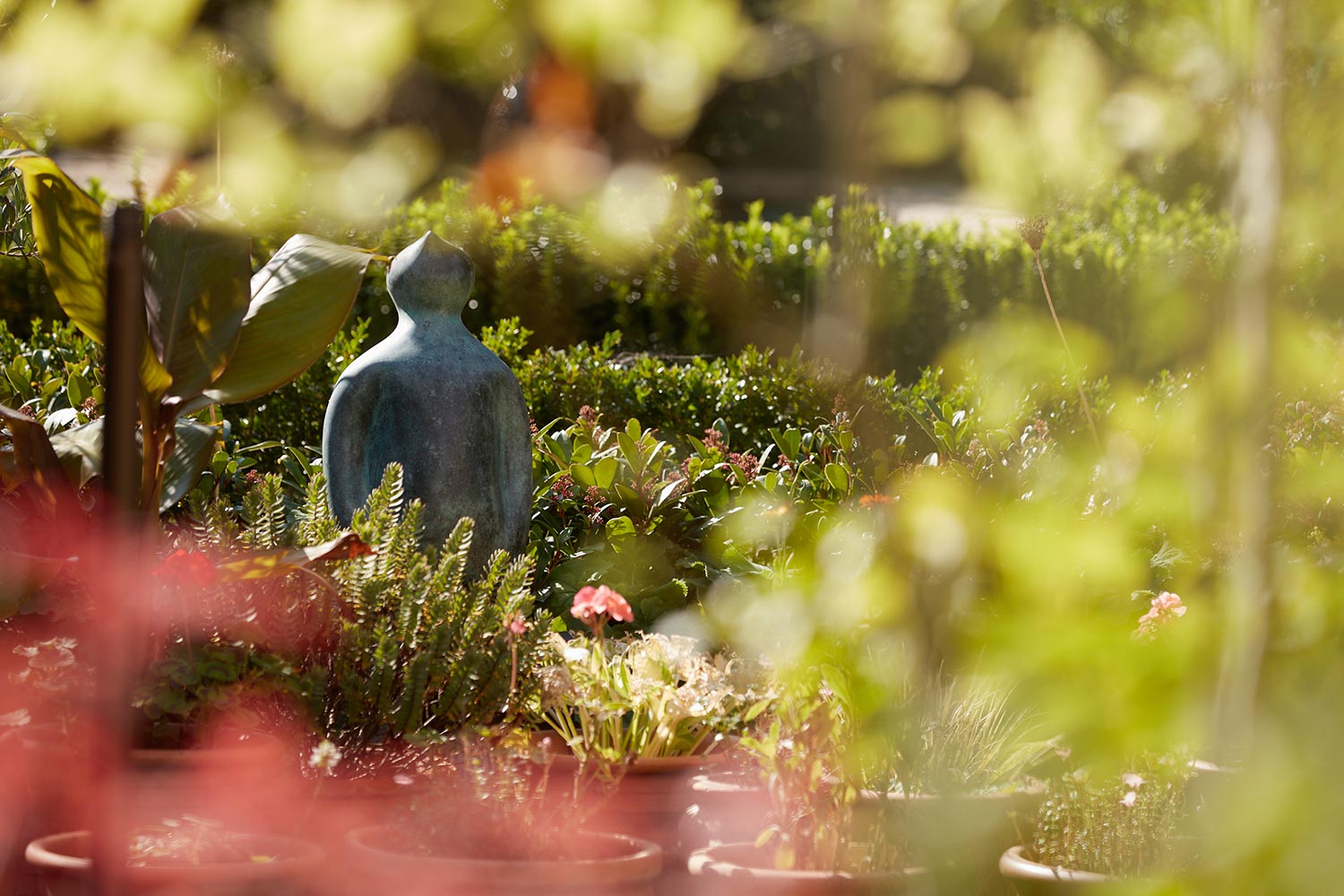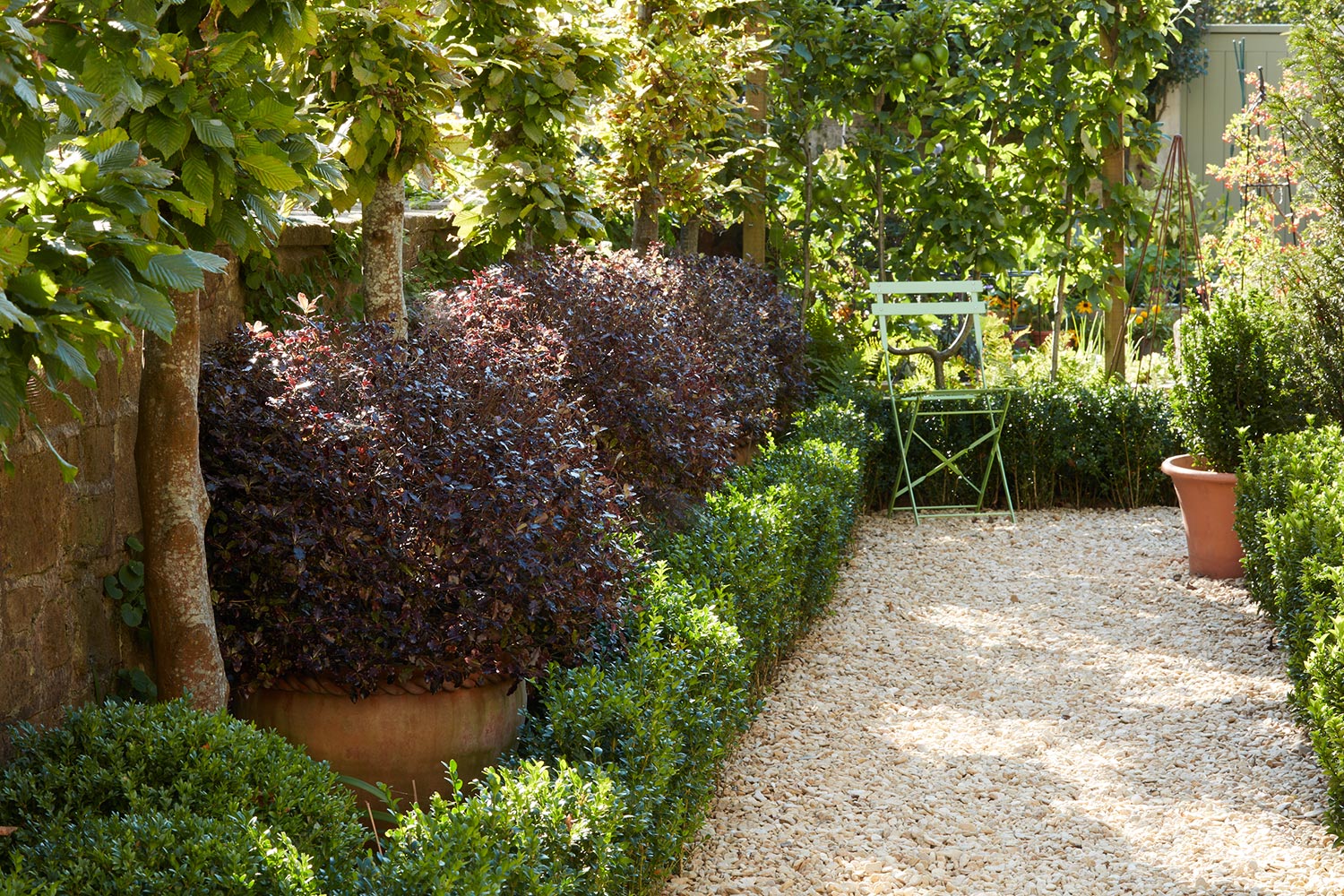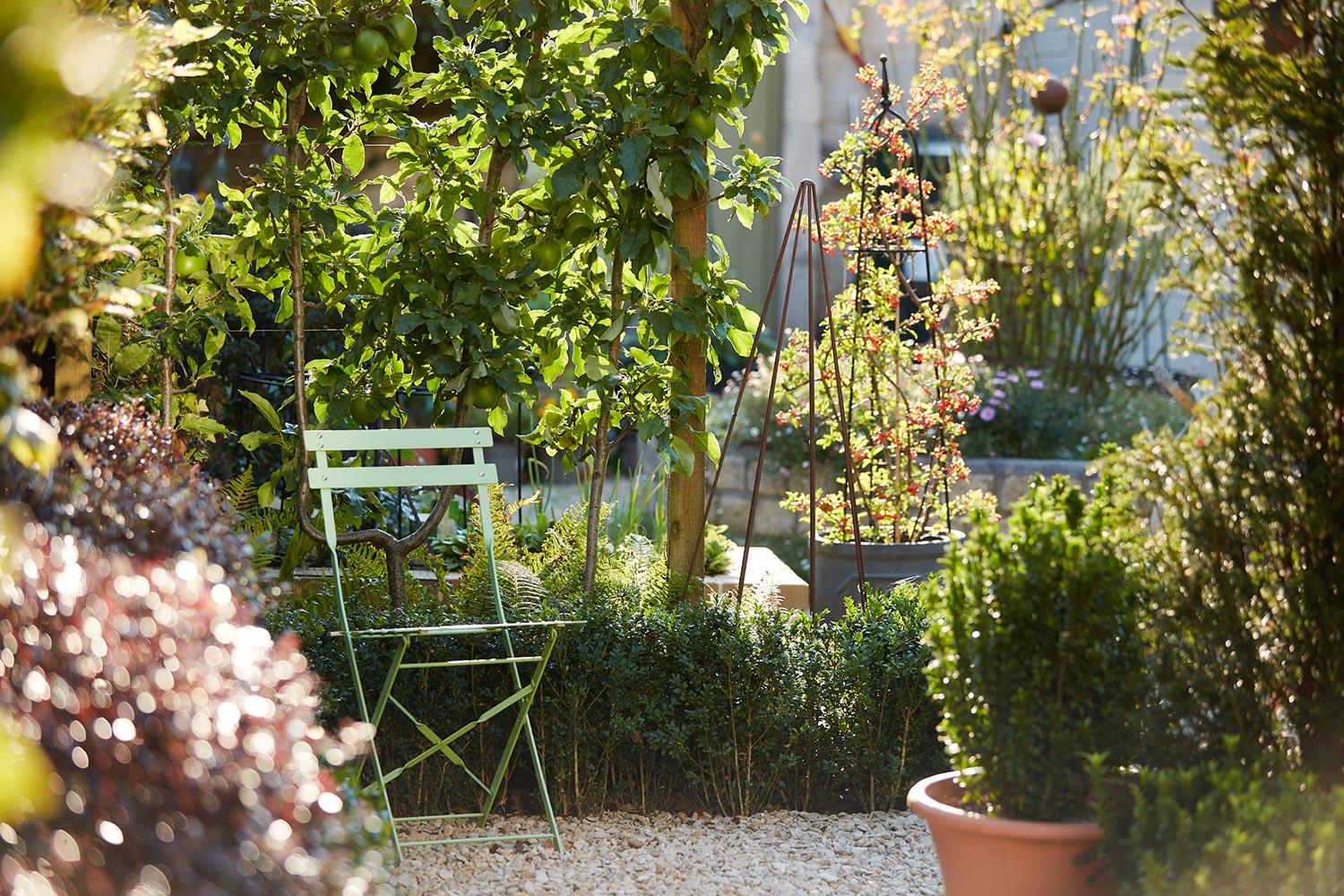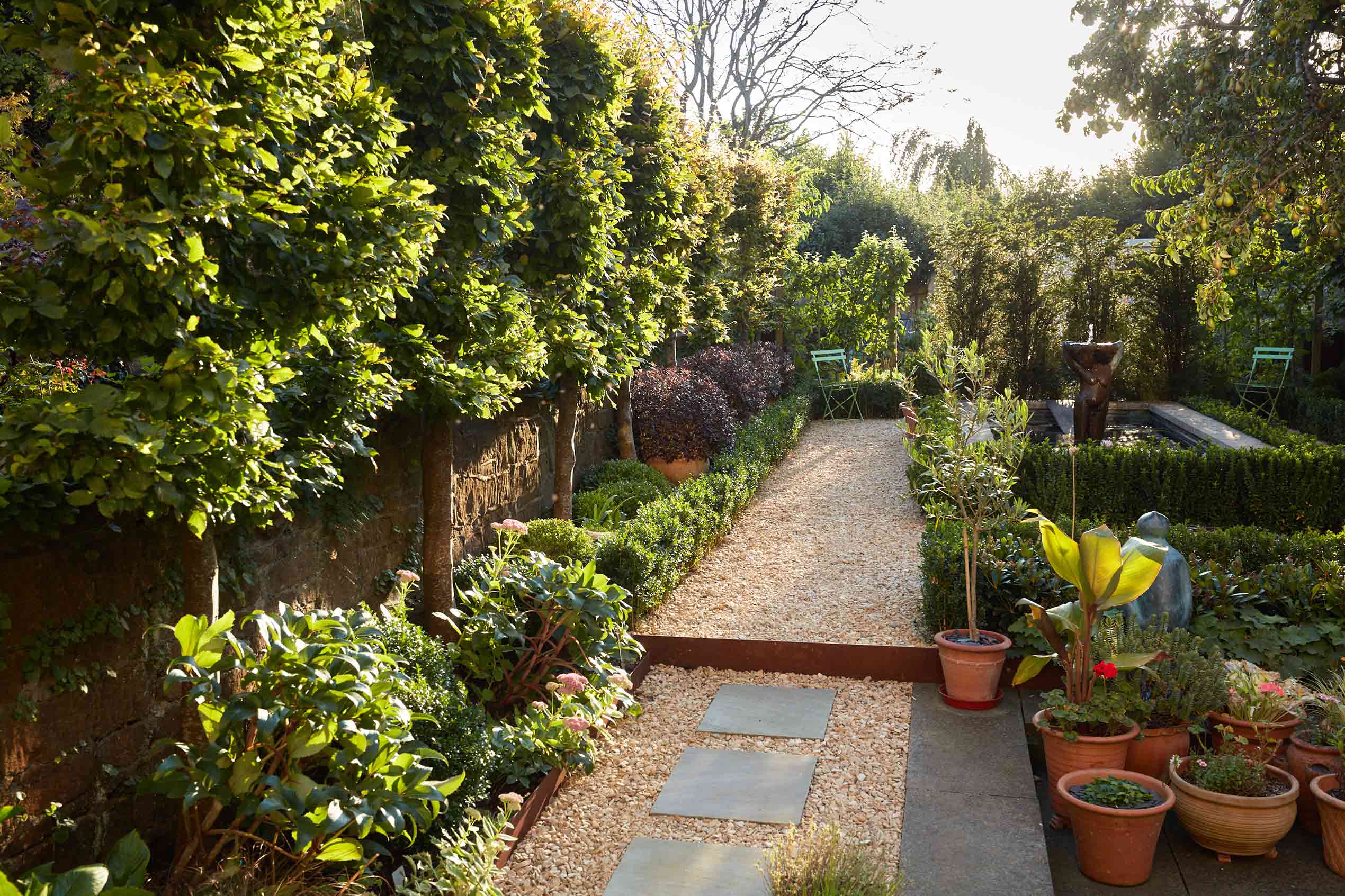. .
Meet the designer – Lynne Bridge
Georgian and historic garden designer

Lynne Bridge runs a garden and landscape design practice based in Bath, working for clients across Somerset and further afield in London and Edinburgh. Her main area of expertise is listed gardens of private residences and some newer family homes. However Lynne’s experience and background extend beyond the norm. Years of formal training as a designer, horticulturalist and historian distinguish Lynne Bridge from other designers. As a result, she has a professional set of skills that enable her to provide a high-level design service.
We interviewed her to find out more about her background and her work.
What drew you to the garden design profession?
My previous career enabled me to work in Asia and other parts of the world where I saw beautiful gardens created in all sorts of environments, and a horticultural mystery how these were achieved. I finally decided to make a career change later in life. I trained for four years as a garden designer and conservationist of landscapes at university in Edinburgh and Bath, then further years of academic research of historic gardens. Only then did I feel confident to work professionally with my drawing skills and horticultural knowledge. Garden design is a ‘future proof’ career, I came to realise, as many well-known designers continue to work till late in life.
In addition to your extensive experience and training, what sets you apart?
During my years of formal training as a designer, horticulturalist and historian I took the route of hand-rendering concepts, ideation and master plans as opposed to CAD and other digital platforms. My drawing skills are well honed over the many years of working as a designer, clients enjoy the design process with plans that are hand drawn to scale, sometimes with supporting models. The approved master plan can then be given to Planning, contractors and nurseries, all working ‘off the same page’. I like to keep paperwork to a minimum.
How do you spend your time at work?
No two days are the same. When several projects are running simultaneously at different stages of development one may be on the drawing board, another may be in the process of estimation and another might be on site – and sites may be in different cities. Logistics and time management are constant considerations. Running projects smoothly whether in my studio or outdoors alongside clients, contractors, deliveries, tree and plant suppliers, Planning officers, changing weather and hours of daylight during the winter – sometimes conspire to defeat us but we always get there in the end. Many clients are still friends!
What do you most enjoy about your work?
The variety, every garden is different, every client is different, and conditions within a garden whether new-build villa or Georgian restoration are different. Starting from Ground Zero every time with a clean sheet of paper is refreshing and exciting. The people I work alongside are positive contributors to enjoying my work – whether strong men wielding tools, digger operators, stone masons, tree surgeons, plant growers, delivery men, skip movers – all are hard working, make constant efforts, chivalrous and whatever the weather work together as teams to achieve goals – creating beautiful gardens for our clients off the same hand drawn plan on a sheet of paper.
When you first plan a garden design, what do you start with?
I like to start the design process with the clients. We look at their outdoor space – all are different, some derelict and some bleak, some gardens clients simply do not like. I’ve trained myself over the years to ‘listen’ to what they are saying at this early stage, often it is heart-felt, accurate and when a couple are going forward together with their garden they usually have discussed at some length their expectations and ideas. This to me is the most informative moment as a designer. I then move onto function of space, structures they may want, plants they are drawn to, before commencing with concepts and recommendations.
Are you able to take any creative liberties with the historic projects that you work on?
The history of garden design is filled with eccentrics through the centuries. The large estates and homes were designed and built by characters who had cycles of wealth that they invested into their properties, usually with their own ideas and creative liberties, both inside and out. These days we have guidelines in place through protective laws to ensure conservation and restoration are respectful of the centuries that have gone before. These are broad and with training and experience the areas for my own ‘creative liberties’ within historic settings are recognisable and open to interpretation with clients. In reality we are still using similar stone, materials and plants through the centuries. Just in different positions and combinations to suit more contemporary life and usage.
How do you balance the need to create a landscape or garden design that belongs to a historic property yet also has to function as a modern outdoor space?
The uses made of the same garden have varied through the generations. An 18th century Georgian garden depending on its size may have contributed not as a ‘rear garden’ but to the workings of the house for deliveries, storage, waste management, household access. Through the centuries the same outdoor space evolved. Perhaps to become a designed flower garden with clipped box hedges to be walked through and admired from indoors. Then it became a necessary wartime kitchen garden later replaced with a lawn and finally left to itself. In more recent times the same ‘historic garden’ is viewed as additional ‘outdoor rooms’ for seating, entertaining, flower and produce growing, storage, peace and quiet. Gardens have always worked hard.
Are your gardens always designed for the long-term, or are you able to add shorter-term elements such as bright borders, or specific plants?
Historically gardens are expected to have a 20-30 year cycle following investment by clients. Yes bed installations may change with flower ‘fashions’. But when considering the years it takes for a Yew hedge to grow and be clipped into shape, a climber to grow up a building, espalier trees to take shape, pleached trees to tie together, getting the structure right at the initial design stage is important. Structure is for the long term and ‘filling in’ with preferred plants and flowers is shorter-term. Sustainability and maintenance are long-term considerations, particularly in more recent times.
Does your approach to garden design change over time?
There are ‘fashions’ that influence design – we only have to watch Chelsea Flower Show – but in the main there are site conditions, levels, views, vistas, neighbours, heritage issues and other considerations that guide the design during its development. Plant ‘tastes’ change and clients have their own preferences but there are certain ‘combinations’ that work well together, companion and sequential planting plans that require low maintenance and these are often ‘looks’ that clients like in my designs. Ideas are changing in 2020 and self-sustainability or at least growing some produce is becoming increasingly popular. Whether architectural plants like artichokes, chard, rhubarb or courgettes that are attractive seasonal fillers, ferneries with hundreds of Alliums popping through in May, all fit with heritage gardens of the moment.
How important is garden maintenance when it comes to looking after a garden on a historic property?
Very important. All gardens need maintenance of some sort, even a planter needs feeding, cleaning and replenishing. Many clients today include in their brief ‘low maintenance’ but there is always seasonal attention required. Historic gardens by their definition will have hedges, trees – deciduous and coniferous – climbers, bulbs and herbaceous plants that are continually growing at their own pace. Twice yearly cutting of hedges, pruning Wisterias, gentle tweaks to Magnolias and Maples, tight cuts to topiary. And of course lawns that go over quickly in the summer without regular cuts.
What do you enjoy the most about working in Bath and the Somerset area?
Bath and the Somerset region are wonderful backdrops to landscape design, conservation and installation of gardens. The honey-coloured Bath stone, beautiful panoramas, the history and importantly the UNESCO World Heritage status gives the region some protection from indiscriminate ‘design’. Bath is well located for travel to London and Bristol Airport though we are doing less of that in 2020.
Do you have any favourite plants?
Yes but it depends on location of the project. Bath soil supports plants that ‘fit’ with the surroundings and grow easily. For example Magnolia, Acers, Hydrangea petiolaris, Wisteria, Pittosporum and Alliums. Edinburgh has acid soil where Hydrangea are blue, Azalea, Rhododendron, Camellia all flourish. Some of my favourites that do well in both areas are Amelanchier, Ceanothus, Paeony and ferns. Unfortunately Box blight has spread and in Bath and London many gardens are infected. More recently they have been further attacked by box tree moth. I no longer specify Buxus as edging or topiary. I’ve replaced it with Euonymus japonicus and plants that can be clipped into shapes. These are all plants that I favour because they work hard, require little maintenance and look beautiful.
How important is sustainability in the gardens you design?
It is a priority and particularly water and drainage are at the forefront of any design. Lawns are coming under increasing criticism for use of resources. I like to use the existing materials in a garden as much as possible. Stone can be incorporated into raised beds, soakaways drain off excess water, plants relocated or donated. Materials brought in should come from local areas as much as possible. Composts and topsoil from Gloucestershire, pavers reclaimed, repurposed from the site or from accredited suppliers. Gravel from local quarries. Interestingly when these materials are placed together they do ‘fit’ and blend with the surroundings. Plants initially are sourced from local tree nurseries and growers. Or from further across the country where they are adapted and ‘hardened off’ to our weather and settle in quickly. There is increasing need for ‘native’ species that are adapted to conditions and suffer less from pests and disease.
What is your favourite tool as a designer?
My Rotring drawing pen in my studio and anything Niwaki outdoors!


Many thanks Lynne for agreeing to be interviewed. Lynne is one of several local garden designers we have forged close relationships with. See our Design page to see who they are. If you would like to contact Lynne Bridge, she can be reached on the details below:
Contact Lynne Bridge:
Lynne Bridge
M: 07855309110


